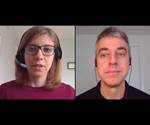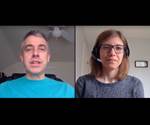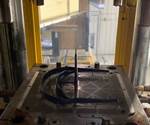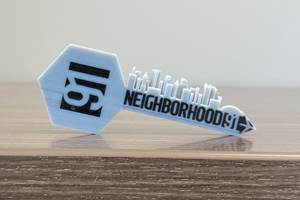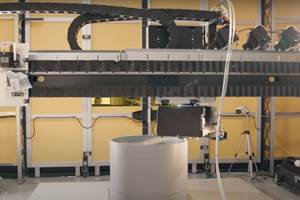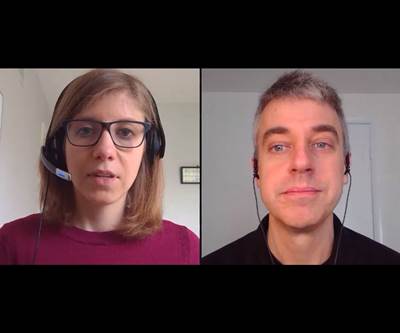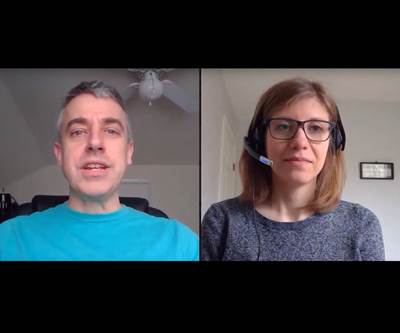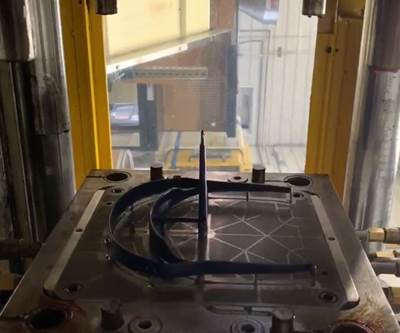3D Printing and Coronavirus Check-In - Week of 4/6/2020
Editors Peter Zelinski and Stephanie Hendrixson discuss the pivot to production for 3D printed PPE, and other AM news in the fight against COVID-19.
Some of the issue raised in this discussion are also addressed in our April 13 video. Find it here.
This week's video reflects a shift that appears to be emerging in how 3D printing is being applied to fight coronavirus. We seem to be moving past independent, isolated efforts and toward greater organization and guidance, higher volume 3D printing, and in some cases a shift to more conventional production techniques for PPE, ventilators and more.
In this conversation we discuss 3D printing’s pivot to production; additive manufacturing as a bridge production measure for ventilator parts; personal protective equipment (PPE) for use by first responders and others outside hospitals; 3D printed testing swabs and more.
Resources and links
- PPE Made in the USA
- Makerforce
- 3DHEALS’ “Can 3D Printing Save Us From COVID19 Crisis?” Webinar
- Rapid Application Group Pivots to 3D Printed PPE
- Linear AMS Is an Additive Manufacturer and a Molder
- Essentium’s Production FDM Platform
- The Additive Manufacturing Conference
- Gardner Business Media’s COVID-19 reporting
Transcript
Peter Zelinski
I’m Pete Zelinski with Additive Manufacturing dot Media.
Stephanie Hendrixson
I’m Stephanie Hendrixson, also with Additive Manufacturing dot Media.
Peter Zelinski
Manufacturers have changed course this year in response to the COVID-19 crisis. Additive manufacturing is a big part of the story. So we've changed course too now. Once a week or so we're going to check in with a video like this to let you know what we're seeing. Stephanie, what are you seeing this week?
Stephanie Hendrixson
So Pete you said “change course.” And I feel like this week especially that's something that we're seeing in the manufacturing space. We're seeing 3D printing companies and more traditional manufacturers really pivot to production. They're focused on making PPE, making ventilators, making other items to deal with this coronavirus situation.
Peter Zelinski
Yeah, so pivot to production. That's right. And production manufacturers. The maker community kind of dove into this crisis right away, including hobbyists. Users of 3D printing producing PPE, particularly face shields, kind of demonstrated one of the real strengths of 3D printing, which is it is the manufacturing process with the shortest lead time, able to react the fastest.
But that response has been different in different regions of the country. We kind of talked about that a little bit last week, different levels of connectedness to hospitals, different levels of effectiveness meeting the hospital's needs. Also, arithmetic works against these folks. These small sort of desktop FDM printers, they're really not made for fast production, for scale production.
Some maker groups have responded to this just with raw numbers like bringing together coalitions of lots of 3D printer users and I've talked to a lot of these groups, a lot of representatives of these groups, really too many to mention.
Here's a photo that came late yesterday. This is from James Hoffman. He's a STEM teacher at Newton High School in Newton, New Jersey, and he's leading a group of about 40 makers and their 3D printers. The effort is called PPE Made in the USA. And it all started with an appeal from Rutgers New Jersey medical school, actually now there are seven different school systems involved in the effort.
Another example, here's another couple of photos. Shashi Jain, in the Portland, Oregon area, his day job is working for Intel. He's organized a network in that area of about 150 different 3D printers. They have volunteers now this group delivering PPE to hospitals in the area. The photo you're looking at actually shows a pharmacy, but same principle. You get the idea. Go to makerforce.org to learn more about their efforts. A couple of examples there.
And what these really show is, is the heart—among other things—just the heart to get involved, serve and help. These are like the 3D printing first responders.
But we're seeing now what comes next. Right? We're seeing industrial production scale, 3D printing, additive manufacturing, coming online and and the picture’s shifting; the picture’s clarifying a little bit. I think you have an example of that. Stephanie, am I right?
Stephanie Hendrixson
Yeah. And so just to kind of pivot off of what you just said about the whole maker movement. You know, I sat in on a 3DHEALS webinar earlier this week where there were there were medical professionals, there were manufacturing people in this webinar talking about all these different issues. And this is something that came up you know, setting aside the the materials and you know, potential porosity with with items that are made with an FDM printer, the numbers kind of don't work in your favor. You’re not going to be able to produce tons and tons of face shields or whatever other equipment there might be. So there are other manufacturing techniques that are going to be more productive. There are even other 3D printing techniques that are going to be more productive.
So the example that I want to talk about today is company called Rapid Application Group. They're in Tulsa, Oklahoma. And they are a aerospace manufacturer that is now making face shields and making masks, respirator masks. But they are using equipment from 3D Systems and EOS. These are selective laser sintering, SLS, printers. So it's a powder bed process. And the nature of that process is such that you can nest your parts inside the build platform, and you can nest them vertically as well as in the X and Y. And so they're saying that they're going to be able to print something like 300 of these respirator masks in a day, which is almost 2,000 in a week. So the scale there is much, much higher than what you're going to get with an FDM printer. But you know, even there, there's they're also looking at mold tooling, they're thinking about ways to take this production even even higher.
I think they are a really interesting case though, because they are manufacturing items that are PPE. But talking to them, it's not a really simple process. It's not, you just get the approved file and you use the right material. And like that's, that's all that is. They put a lot of work into designing this respirator. It's supposed to be an N95 alternative. When I first talked to them last Thursday, they were not seeking approval for this to be used in a clinical setting, soo doctors actually treating COVID-19 patients. Instead, they were really focused on first responders, they wanted to get these masks out to EMTs, to medical support staff. They've sort of changed direction now and they do want to seek that clinical approval. And they've developed as a design that that might get there.
So it's two different laser sintered pieces that fit together, and then you're able to put an N95 filter into the mask. And so one one existing filter could potentially be used between four and six times in a mask like that, so you're getting a lot more use out of the existing material. But they are also going through the fit testing process. So they have actually used a local health clinic to make sure that that the mask seals, and that it's going to be effective in protecting people the way that they think it will be. And the material that they're using is, is a nylon material, it's biocompatible, it's safe for contact against your skin. In the design that they have, they actually have sort of a gutter in the mask where you can put a piece of food-grade silicone tubing, so that's what's actually forming the seal around the mask. It's not directly nylon onto your skin.
But all that to say, there's a lot of different things that they had to think about. And I think that Rapid Application Group is actually a good example of a company kind of going above and beyond, to the point that their CEO posted a video on LinkedIn where he put the mask on and ran a mile on the treadmill to test the airflow.
The other thing that I want to point out here is this is an industrial 3D printing company. And they are an aerospace manufacturer, they know how to work with with regulations and standards and this kind of thing. And even they are saying, you know, we're not a medical company, we don't have all the equipment that we need to do this exactly the right way. So just for example, the material that they're using is something you can put in an autoclave, which is really important if it's going into a hospital, but they don't have an autoclave. So what they're doing is they've taken their mechanical testing lab, cleared all the equipment out of there, and they're doing a bleach dipping process to make sure these are clean, but they're not sanitized. So when they go into a medical facility like a hospital, for instance, they're going to need to go through that autoclaving process.
So even a company that is set up for 3D printing for production in another end market, another specialty, is not going to be able to make that pivot supers seamlessly. There are some things that they've had to learn, some things they've had to figure out. And you know, there are standards and protocols in place that we have to follow.
Peter Zelinski
So something I kind of picked up on in there is he said, in spite of the fact that they've got a production volume 3D printing process, they are looking at molding maybe as a possibility to get the quantities that they need. You know, the big story in production right now in the COVID-19 crisis is ventilators. We're seeing manufacturers across the country around the world actually shifting to production of ventilator components in this race to try to produce enough ventilators to keep up with the quantity of sufferers we expect to see as this illness surges. Additive manufacturing plays a role here, but in many cases, that role is bridge production. Here's an example.
Linear AMS, we've written about Linear in in various occasions on Additive Manufacturing dot Media, a user of production quantity 3D printing. They have both metal and polymer 3D printing. They use HP’s Multi Jet Fusion process, again capable of production quantities, depending on how you define production, through their additive manufacturing but they're using additive now, for initial production, get parts out there, get parts validated. But Linear AMS is also a molder, injection molder, and they're ramping up to do high production injection molding of these components that they're producing.
Additive manufacturing as a scale production option, it's best suited for parts that are designed for additive designed to take advantage of the freedoms that additive brings, the new possibilities that it brings. And of course, the ventilators don't fit that description. The ventilators were made for conventional production processes. We're just trying to produce more of the same kind of ventilators we already have. And so those conventional processes are what really are the strongest hope for production providing the production quantities that we need. It took a little longer for conventional production to get fully engaged. But maybe now we're seeing this moment where where additive manufacturing, which was the explosive sprinter right out of the gate, is handing off the baton to the distance runner, conventional manufacturing, that's going to take us all the way to the rest of the solution. Stephanie, what else are you seeing?
Stephanie Hendrixson
So something else that's kind of come up recently, and I think it could be an example of that kind of bridge production like you're talking about, is testing swabs. So these are the nasal swabs that your medical provider would use to test you to see if you have COVID-19. Under normal circumstances, they're not used that frequently, but they might be used to test for just the regular flu. And we're facing a shortage of those right now that's one of the contributing factors to the lack of testing is just the lack of swabs. And, as I understand it, the main manufacturer of the the swabs that are typically used is located in northern Italy, so an area of the world that's been particularly hard hit by this pandemic. And so something that I just recently learned about this week is that there are a number of 3D printing companies, they all use DLP technology, the ones that I'm aware of, so Carbon, Formlabs, Origin, are looking at 3D printing these test swabs. I don't have all the information about that right now. But I'm hoping that next week, I'll be able to share a more more thorough update about what's going on there. Pete, what else do you have today?
Peter Zelinski
Maybe one other little thing — not so little. So we talked about how one of the consequences of sort of 3D printing’s organic community-level response to this is that some of the hospitals in more active 3D printing regions have an advantage in this. So, like, what region do you think would have the very best advantage potentially? Do you have a guess?
Stephanie Hendrixson
That's a, that's a difficult guess. I would probably say probably like the Boston area, like around MIT.
Peter Zelinski
Good guess. Good guess. So here's a picture of first responders in Pflugerville, Texas, benefitting from 3D printing. So this is the Austin area, which is a center, another center like Boston of additive manufacturing activity in the U.S. We held our most recent Additive Manufacturing Conference in Austin. Essentium, located in the Austin area, they make this fast production speed FDM printer, this additive manufacturing system and Essentium is using it to print masks that are aimed at first responders. Essentium is also seeking FDA approval to allow these masks to be used as surgical masks.
But the first responder inclusion is a really important point. It's not just hospitals that are in need of PPE. It's not just hospitals that potentially could suffer from a PPE shortage. So the Pflugerville Police Department got the first order. I learned a little bit about this mask from Nirup Nagabandi who is an engineer with Essentium. The mask is like a frame and it holds a disposable filter media over it and essentially, with each mask they provide a supply of this filter media. They're getting ready to go into scale production of these masks. They expect to make 5,000 of them per week. First responders who are interested in getting an order of these, first responder organizations, you can contact essential directly.
Stephanie Hendrixson
So a couple of things to respond to there. Just very quickly, I think the first responder point is a great one. And I'm hearing about other facilities like say hospice and nursing homes, not to mention, you know, food service and other industries where people are in need of PPE, and it doesn't necessarily have to be doesn't have to be surgical grade, doesn't have to be suitable for clinical setting, but something like a face shield can be can be really, really useful or a mask like what you're describing.
Another thing and this came up in in the 3D heels webinar is that you know, a lot of these 3D printing efforts are extremely local. So the the Pflugerville situation, any place where there's kind of a concentration of 3D printing enthusiasts or experts. One of the things that came out of that webinar was, you know, make sure that there's a need before you start printing things and find out what that need is. And so people, the the experts that were that were talking in that video were encouraging people to you know, reach out to your local healthcare professional, reach out to your local hospital. I think that is going to be the biggest win for 3D printing in this situation, you know, it's local, it's fast, it's flexible, it's maybe not going to make huge quantities, but there can be needs that are really immediate and really local, where 3D printing could make a big difference.
So that's about all the time that we have this week. We've talked about some different resources that we will link in the show notes below. You can find more information on our website, Additive Manufacturing dot Media, as well as lots of other content. We're trying to keep up with what's going on in additive manufacturing and 3D printing, including but also beyond the coronavirus situation.
Peter Zelinski
We're part of Gardner Business Media which is a media company focused on manufacturing. So you know we cover additive, machining, molding, other sectors, other manufacturing technologies. The whole company right now is compiling stories writing stories about the response to COVID-19 from within different manufacturing sectors and the way that it's affecting different manufacturing sectors. We have compiled all of that coverage throughout manufacturing throughout Gardner Business Media into one collection updated daily, COVID-19’s effect on manufacturing and the response from manufacturing to the crisis. You can find a link to that whole collection at our website, Additive Manufacturing dot Media. Stay healthy.
Related Content
What Is Neighborhood 91?
With its first building completely occupied, the N91 campus is on its way to becoming an end-to-end ecosystem for production additive manufacturing. Updates from the Pittsburgh initiative.
Read More3D Printed Titanium Replaces Aluminum for Unmanned Aircraft Wing Splice: The Cool Parts Show #72
Rapid Plasma Deposition produces the near-net-shape preform for a newly designed wing splice for remotely piloted aircraft from General Atomics. The Cool Parts Show visits Norsk Titanium, where this part is made.
Read MoreLarge-Format “Cold” 3D Printing With Polypropylene and Polyethylene
Israeli startup Largix has developed a production solution that can 3D print PP and PE without melting them. Its first test? Custom tanks for chemical storage.
Read MoreAdditive Manufacturing Is Subtractive, Too: How CNC Machining Integrates With AM (Includes Video)
For Keselowski Advanced Manufacturing, succeeding with laser powder bed fusion as a production process means developing a machine shop that is responsive to, and moves at the pacing of, metal 3D printing.
Read MoreRead Next
3D Printing and Coronavirus Check-In - Week of 4/13/2020
In this week's update we discuss how additive manufacturing is supporting injection molding for masks, and ramping up to production quantities of face shields and testing swabs.
Read More3D Printing and Coronavirus Check-In - Week of 3/30/2020
In this week's discussion, editors Peter Zelinski and Stephanie Hendrixson discuss face shield visors and masks; ventilator components; and new movement from the FDA on 3D printed devices.
Read More3D Printing and Coronavirus: U.S. Additive Manufacturers Share Their Experiences
The COVID-19 outbreak has brought both setbacks and opportunities for American manufacturing. 3D printing companies share their stories.
Read More
.jpg;width=70;height=70;mode=crop)

